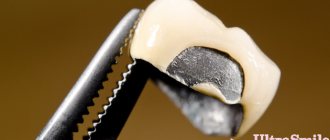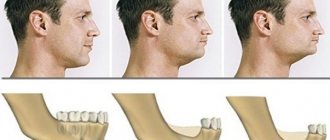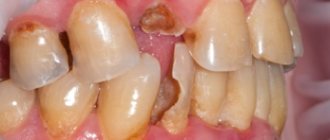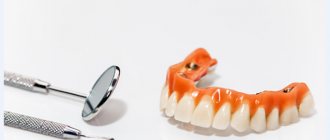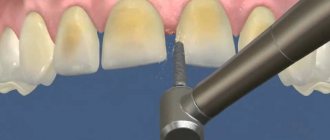Is it possible to remove the crown?
Almost every patient who has undergone orthopedic treatment wonders whether it is possible to remove the crown from a tooth. Installing a crown is a non-removable type of prosthetics, but this does not mean that they cannot be removed in principle. In dentistry, removable dentures are those structures that can be pulled out of the mouth independently. In turn, fixed dentures are removed in the dentist's office using special equipment and tools. Another popular question: which doctor removes crowns from teeth? This should be done by an orthopedic dentist, but in some clinics the therapist also removes crowns, which, of course, is not entirely correct.
Method No. 1: sawing with a boron
So, let's figure out whether it is possible to remove a crown with permanent cement.
The method of removal using boron is the oldest and by far the most unaesthetic. This means that after using this tool, the sawn artificial material will only have to be thrown into the trash bin, because it can no longer be used for its intended purpose, that is, it will no longer be possible to re-prosthetize a tooth with it.
The technique is simple, cheap and quite effective, but it must be used by a doctor who has a high level of professionalism, because the approach requires caution and precision. An inexperienced specialist may damage the tooth itself or the soft tissue around it during the dismantling process.
With this method, it will not be possible to reuse the crown
“We removed the crown from the tooth with a regular bur and simply sawed it in half. There’s nothing terrible, but when the material got very hot, the smell, I’ll tell you, was not very good, plus there were slightly painful and uncomfortable sensations, even despite the fact that I had been given anesthesia before this, and the tooth itself had been under the prosthesis for a long time depulped!"
Mari, review from 32top.ru
This method is used if the patient has dentures made of inexpensive materials, which he would not mind disposing of later. The method is also suitable if the artificial structure itself is mobile or wobbly. Then it is simply sawed to the teeth, then, using special tools, the resulting edges are carefully bent in different directions and removed.
Why is crown removal necessary?
The average lifespan of a standard crown that covers a natural tooth is about seven years. If the crown is installed on an implant, then it may well last for fifteen years. As a rule, the removal of a crown from a tooth is carried out for a number of reasons.
- Errors during prosthetics. Most often, the fault lies with specialists who made a mistake at one of the stages of treatment. Incorrect manufacturing of the product, incorrect calculations at the preparatory stage, the use of low-quality materials - all this leads to the fact that the prosthesis cannot function properly and has to be removed.
- Injuries and mechanical damage, after which further use of the dental crown becomes impossible.
- Diseases developing under the crown. Secondary caries, periodontitis, cysts are complications in which tooth treatment without removing the crown is almost impossible.
- Gum diseases requiring removal of the denture for treatment procedures.
- Expiration date. Each crown has its own lifespan (especially when installed on a natural tooth). If a crown has lost its functional and aesthetic qualities over time, it must be replaced. Often the crown falls out on its own due to damage or destruction of the bonding agent.
- The desire of the patient himself. For example, in order to replace an old metal or metal-ceramic structure with a more modern and aesthetic product.
Dangerous symptoms!
- Constant pain under the crown indicates the development of an inflammatory process and the need for re-treatment.
- Unpleasant odor concentrated in the crown area. It usually occurs due to the decomposition of tissue under the crown or the ingress of food particles, which indicates a violation of the seal.
- The crown becomes mobile. This is due to decay of the tooth or dental cement under the crown.
If you experience the above symptoms in one form or another, we advise you to contact your dentist as soon as possible. After taking an x-ray, it will become clear whether you have a hidden problem and whether the crown needs to be removed.
Bridge or implant: what to choose
Some people are not happy with the way a bridge looks on their teeth (photo below). Others fear that during sharpening, most of the healthy tissue will be damaged, and the supporting elements will simply fall off. There are other negative aspects that doctors pay attention to:
- pressure is unevenly distributed on the chewing surface in the oral cavity;
- the enamel suffers because its integrity is compromised;
- the product has a short service life.
Even if metal ceramics were installed, in no more than 10 years it will become unusable. This is one of the factors that can influence the choice of implants, which guarantees the preservation of an attractive smile for decades. However, it is up to the attending physician to decide what is preferable to mount.
The patient expresses his wishes regarding the appearance and final cost. Before making a decision, it is important to compare all the advantages and disadvantages, and then settle on one or another design, depending on your financial capabilities.
Successful combination
It also happens that the best solution is to use a complex model that combines the simultaneous installation of one of the types of dental bridges on the teeth to restore lost units and implantation of an implant. This happens in situations with complete edentia, that is, when the mouth is completely empty, and there is nothing to attach the bridge structure to.
In this case, artificial elements are mounted as a support, and the prosthesis is fixed between them. This is the best option for patients who would never agree to wear dentures.
How are crowns removed from teeth?
There are several ways to remove dental crowns.
Sawing
An old and rather crude way. After this, it is no longer possible to remove the crown and put it back. The technique is considered cheap and quite effective, but the final success largely depends on the experience of the doctor - a tooth or gum may be damaged in the process.
Removal using a Kopp apparatus
The Kopp apparatus is a special tool that resembles both a refueling nozzle and a hook (due to the hook-shaped nozzle). The doctor grinds off the cement at the base of the crown, then picks it up with a tool and presses the release. This is a fairly quick and effective method with the only drawback - during the extraction process, chips of the prosthesis may occur.
Ultrasonic crown removal
Involves destruction of cement using ultrasound. The method is well suited for removing old crowns. However, if the material is too dense and strong (for example, glass ionomer cement), ultrasound may not be able to cope with it.
Removal using the Coronaflex device
The operation of the Coronaflex device, which looks like a pistol from the future, is based on the principle of compressed air. The air flow is supplied under high pressure, destroys the cement, but at the same time has a gentle effect on the crown and adjacent tissues. Removing a prosthesis using a device will cost significantly more than other methods. However, if you have a zirconium crown costing 25,000 rubles, it makes sense to overpay a little.
Method No. 2: using ultrasound
Are you wondering how to remove a crown from permanent cement in one of the safest and most innovative ways, and without causing any damage to it? Then ask your dentist if it is possible to use ultrasound in your case. Through impulses, the doctor acts on the cement composition, which gradually cracks. The specialist moves along the “tooth-crown” boundary; under the influence of vibrations, the cement is destroyed.
The product can be removed using ultrasound
The procedure really allows you to remove the structure in its original form, but it has a number of disadvantages. First, ultrasound has a rather gentle effect, so it is not always possible to achieve the goal the first time, and sometimes you have to visit the doctor several times. Secondly, only products that are made from not very dense materials are amenable to hardware exposure to sound waves. For example, it will not be possible to remove structures made using glass ionomers using ultrasound. Third, vibrations may be unpleasant for the patient.
Does it hurt to remove a crown?
No, especially if the procedure is performed under anesthesia. Removing a crown from a tooth is painful if there is a living tooth underneath it that is undergoing an inflammatory process, but in the vast majority of cases, crowns are placed on pulpless teeth. In such a situation, the procedure may cause some discomfort, but you most likely will not experience severe pain. If your teeth hurt after removing crowns, there are two options. Either mechanical damage has been caused to the gum, or pulpitis, periodontitis or granuloma develops in the tooth. In this case, complex endodontic treatment is required.
Indications for tooth extraction
Tooth extraction along with a crown is done urgently or routinely in the following situations:
- purulent inflammatory process on the roots of the tooth, which cannot be controlled with medication and does not go away after drainage;
- acute osteomyelitis, periostitis or phlegmon of the jaw, which do not respond to conservative measures and serve as a source of odontogenic infection;
- tooth fracture, in which it is impossible to restore its integrity with filling materials or a stump inlay;
- the presence of a focus of chronic infection in the periodontium and the inability to complete endodontic treatment (obstruction, curved root canals, perforation of the tooth cavity or root wall);
- severe tooth mobility (grade 3 periodontitis), tooth protrusion by more than 2/3.
Treatment of a tooth under a crown without removing it
In dental practice, there are cases when it is possible to cure a tooth without removing the crown. Usually we are talking about secondary caries and simple endodontic manipulations, carried out through a hole, which is then filled with a composite material. In some cases of surgery, such as cyst removal, the surgical site is accessed through an incision in the gum. In this case, the product usually still has to be removed for additional manipulations.
Rehabilitation period
If necessary, the doctor will prescribe medications and painkillers. It is equally important to follow a number of rules for the first 3-4 days that will prevent the development of complications:
- Do not rinse your mouth.
- Do not chew or brush your teeth on the extraction side.
- Do not take a hot bath or visit a bathhouse or sauna.
- Do not engage in sports or heavy physical labor.
- Avoid air travel (especially if the operation was on the upper jaw).
2-3 days after removal you should come for a follow-up examination, and after 5 days the sutures are removed.
To the list of posts
Caring for zirconium crowns
It is very easy to care for zirconium tooth crowns, just like you would care for your own teeth. After installing zirconium crowns, it is enough to follow the following rules:
- do not chew nuts, candies and other hard foods; but with zirconium crowns you can eat apples and nibble on chocolate;
- brush your teeth twice a day with a regular toothbrush and toothpaste;
- rinse your mouth with water after eating;
- if there are food particles left in the interdental spaces, you need to remove them using dental floss or an irrigator - a device for cleaning the dentition with a jet of water under pressure;
- professional dental cleaning should be carried out twice a year;
- control by an orthopedic dentist - at least once a year.
With proper care, zirconium dioxide crowns will last a very long time.
